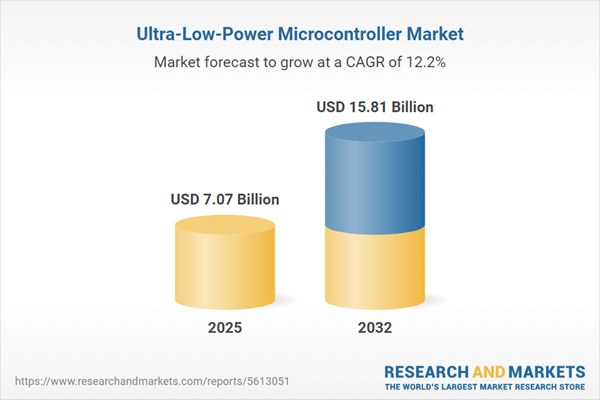Speak directly to the analyst to clarify any post sales queries you may have.
The ultra-low-power microcontroller market is emerging as a key enabler of efficient device intelligence across connected environments. With demand accelerating in sectors requiring longevity and optimized power use, these microcontrollers deliver the architecture and functionality central to next-generation applications.
Market Snapshot: Ultra-Low-Power Microcontroller Market Size and Growth
The ultra-low-power microcontroller market grew from USD 6.31 billion in 2024 to USD 7.07 billion in 2025 and is expected to register a CAGR of 12.16%, reaching USD 15.81 billion by 2032. This elevated growth trajectory reflects intensifying demand for microcontrollers that combine energy efficiency with robust computing power, supporting use cases from wearables to industrial controls. The expansion is underpinned by continued innovation in subsectors such as automotive, healthcare, and consumer electronics, where efficient embedded intelligence is critical to value creation.
Scope & Segmentation of the Ultra-Low-Power Microcontroller Market
This report provides comprehensive segmentation and analysis, covering the following dimensions:
- Core Architecture: Profiles include 8-Bit, 16-Bit, and 32-Bit solutions, each serving distinct application environments with varied computational and power requirements.
- Connectivity: Examines Bluetooth, Thread, Wi-Fi, and Zigbee integration, encompassing wired and wireless communication standards tailored to diverse operating scenarios.
- Application Verticals: Features segmentation by Aerospace & Defense, Automotive, Consumer Electronics, and Healthcare, highlighting unique demands in each sector.
- Regional Coverage: Analyzes the Americas (including North America, Latin America), Europe, Middle East & Africa, and Asia-Pacific, with further breakdown by key countries within each region.
- Company Analysis: Assesses leading industry participants such as STMicroelectronics, Texas Instruments, NXP Semiconductors, Microchip Technology, Renesas Electronics, Silicon Laboratories, Infineon Technologies, Analog Devices, On Semiconductor, and Nordic Semiconductor.
Key Takeaways for Senior Decision-Makers
- Advancements in semiconductor manufacturing, such as sub-40 nanometer processes, are driving significant reductions in both active and static power consumption for embedded systems.
- The integration of on-chip security—such as hardware-based encryption and secure boot—addresses soaring cybersecurity needs without increasing energy budgets.
- Broadening wireless connectivity standards facilitate design flexibility but necessitate careful trade-offs between protocol choice, power draw, and real-time operating demands.
- Industry collaboration and the formation of integrated software-hardware ecosystems accelerate time-to-market and simplify feature deployment, especially in evolving application domains.
- Emerging regions, particularly in Asia-Pacific, are propelling market momentum through local manufacturing incentives, reflecting the global dispersion of both production and demand.
Tariff Impact on the Supply Chain and Cost Structures
In 2025, new United States tariffs have prompted extensive realignment across global microcontroller supply chains. Suppliers are re-evaluating sourcing models to mitigate increased costs from imported components, often resulting in diversified manufacturing strategies or partnerships with domestic facilities. This shift challenges original equipment manufacturers to manage tighter margins while enhancing supply chain resilience. These changes also foster regional investment, supporting longer-term stability and flexibility in procurement and logistics strategies.
Technological Advancements Shaping the Market
Recent breakthroughs in power management, such as dynamic voltage scaling and advanced power gating, substantially lower microcontroller energy requirements while retaining full computational capacity. The adoption of heterogeneous architectures combining specialized accelerators with general-purpose cores enables tailored solutions fit for energy-constrained applications in automotive, healthcare, and industrial environments. Integrated analog peripherals and refined wireless modules contribute to interoperability and ease of device integration across varied ecosystems.
Regional Dynamics and Growth Drivers
The Americas maintain strong momentum driven by IoT, industrial automation, and regulatory shifts toward energy efficiency. Europe, the Middle East, and Africa are advancing via commercial infrastructure upgrades and heightened security mandates, influencing product design and deployment. Asia-Pacific continues to benefit from dense manufacturing ecosystems and government incentives, accelerating localized development and widespread adoption of ultra-low-power solutions.
Methodology & Data Sources
This analysis is constructed on a dual-method research framework, combining rigorous secondary study of technical documents, white papers, and regulatory filings with primary interviews across the microcontroller value chain. Data triangulation and comparative analysis were applied to ensure robust, credible insights that accurately reflect contemporary trends and stakeholder priorities.
Why This Report Matters
- Enables strategic decisions by detailing energy-efficient microcontroller options, market drivers, and the impacts of global regulatory changes.
- Provides clarity on architectural and connectivity advancements, pinpointing opportunities for innovation in power-conscious device design.
- Supports risk mitigation by illustrating tariff-induced supply chain adaptations relevant to both procurement and production strategy.
Conclusion
The ultra-low-power microcontroller market is rapidly advancing in both technology and application, driven by evolving requirements in connectivity, efficiency, and embedded intelligence. Strategic adoption supports resilience, innovation, and long-term competitiveness in this dynamic sector.
Additional Product Information:
- Purchase of this report includes 1 year online access with quarterly updates.
- This report can be updated on request. Please contact our Customer Experience team using the Ask a Question widget on our website.
Table of Contents
3. Executive Summary
4. Market Overview
7. Cumulative Impact of Artificial Intelligence 2025
List of Figures
Samples

LOADING...
Companies Mentioned
The key companies profiled in this Ultra-Low-Power Microcontroller market report include:- STMicroelectronics N.V.
- Texas Instruments Incorporated
- NXP Semiconductors N.V.
- Microchip Technology Incorporated
- Renesas Electronics Corporation
- Silicon Laboratories Inc.
- Infineon Technologies AG
- Analog Devices, Inc.
- On Semiconductor Corporation
- Nordic Semiconductor ASA
Table Information
| Report Attribute | Details |
|---|---|
| No. of Pages | 188 |
| Published | October 2025 |
| Forecast Period | 2025 - 2032 |
| Estimated Market Value ( USD | $ 7.07 Billion |
| Forecasted Market Value ( USD | $ 15.81 Billion |
| Compound Annual Growth Rate | 12.1% |
| Regions Covered | Global |
| No. of Companies Mentioned | 11 |









